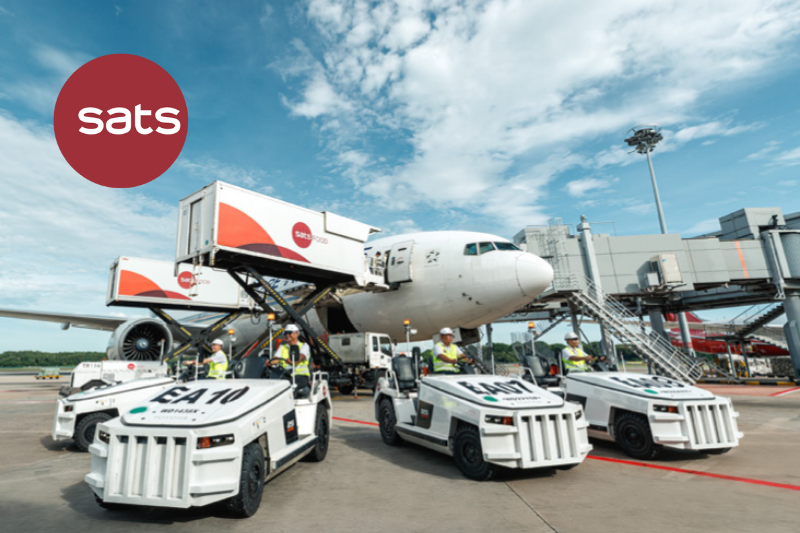SATS Share Price Tumbles Amid S$1.64 Billion Acquisition: 5 Things Investors Need to Know

SATS Ltd (SGX: S58) saw its share price plunge by 20% this morning to a two-year low of S$3.08.
The food caterer has stunned the market by announcing a major acquisition – that of privately-owned Worldwide Flight Services (WFS) for nearly S$1.64 billion.
Prior to the announcement, the group was enjoying a strong recovery with the reopening of borders and the resumption of air travel.
The airline ground handler also reported an improved set of earnings for its fiscal 2022 ending 31 March 2022, with core net loss reduced by more than half to S$8.5 million.
On the positive side, this transaction will propel SATS into the big league and substantially enhance its revenue and earnings profile.
After enduring two years of pandemic-related challenges, the group is seeking a transformational acquisition.
Yet, the market does not seem impressed.
Here are five things that investors need to know about SATS’ acquisition.
1. A leader in the air cargo sector
WFS comes with impressive credentials.
The company is the number one player in North America and Europe for air cargo handling, with 114 cargo stations and more than 800,000 square metres of warehouse space.
What’s more, WFS’s network is complementary to SATS with minimal overlap.
SATS has a presence mainly in the Asia-Pacific region while WFS handles European and US cargo, and the acquisition will provide the combined group with comprehensive global coverage.
WFS also enjoys a contract renewal rate higher than 90%, implying that it has sticky customers that remain loyal to the company.
Revenue for WFS has also increased by 6% per annum from fiscal 2018 (FY2018) through to FY2021 to hit S$2.6 billion, boosted by two acquisitions.
2. Strong infrastructure with a blue-chip customer base
WFS also boasts a strong infrastructure with an established portfolio of around 170 on-airport lease warehouses.
The company offers multi-station solutions with access to key hubs that are supported by a global network.
In addition, WFS has a platform to support ongoing growth in its warehouse space, with the capacity expansion taking place over the last few years through acquisitions and organic growth.

Source: SATS-WFS Acquisition Presentation Slides
The slide above shows WFS’ customer mix which consists of many blue-chip airlines such as American Airlines (NASDAQ: AAL), Qatar Airways, and Air France KLM SA (EPA: AF).
Around a quarter of WFS’ revenue comes from its top five customers, with the bulk (64%) coming from a range of different customers.
The company also works with integrators and freight forwarders such as United Parcel Service (NYSE: UPS), DHL (ETR: DPW), and Amazon (NASDAQ: AMZN).
3. Creating a global powerhouse
This acquisition will create a global powerhouse with SATS and WFS combining their expertise and cargo stations.
Once the transaction concludes, the new entity will have a total of 135 cargo stations around the world handling around nine million tonnes of cargo volume.
SATS will leapfrog to the number one position, putting it ahead of Swissport with 92 cargo stations handling around five million tonnes of cargo.
There will also be cross-selling opportunities across the new, expanded customer base and the larger entity can also accelerate cargo automation to achieve better synergies.
4. Increased diversification and a strong boost to earnings
The acquisition is beneficial to SATS as it helps to diversify its geographic exposure.
For FY2022, around 85% of its revenue came from Singapore.
By FY2025 and with the purchase of WFS, Asia will contribute around 45% of revenue, with the Americas making up 30% and EMEA (Europe, Middle East and Africa) taking up the remaining 25%.
SATS can also enjoy better business segment diversification as slightly more than half (55%) of its FY2022 revenue came from food solutions.
Post-acquisition, it projects that food solutions will make up less than one-third of revenue by FY2025, with half of the group’s revenue coming from cargo instead.
The acquisition will also deliver an immediate positive financial impact.
Revenue is set to more than triple from S$1.2 billion in FY2022 to S$3.8 billion, while net profit will jump from S$1.8 billion to S$3.2 billion.
5. Acquisition funded by equity
Now that you know what SATS is getting, the question that remains is its price tag.
SATS intends to fund the acquisition purely through equity and internal cash flows.
The group has signalled its intention for an equity fundraising exercise to raise S$1.7 billion, and the plan will assume all of WFS’ debt of around S$1.7 billion.
Once consolidated, SATS will see its debt-to-equity ratio jump from the current 46% to 71%, with its net debt to EBITDA (earnings before interest, taxes, depreciation and amortisation) soaring from 0.5 times to 3.4 times.
Details of the fundraising have yet to be determined but may comprise a renounceable rights issue to existing SATS’ shareholders along with a private placement to institutional investors.
An extraordinary general meeting will be convened in early 2023 to vote on this major acquisition.
Temasek Holdings, which owns around 40% of SATS, has agreed to vote in favour, thus throwing its weight behind this transformative acquisition.
However, investors should note that with SATS’ increased debt load, it may take a while before it can resume paying out a dividend.
How do you decide if a growth stock is worth your money? There is no shortage of stock ideas today, but is a particular stock suitable for you? Find out more in our latest FREE report, How To Find The Best US Growth Stocks For Your Portfolio. Click HERE to download the report for free now!
Follow us on Facebook and Telegram for the latest investing news and analyses!
Disclaimer: Royston Yang does not own shares in any of the companies mentioned.
The post SATS Share Price Tumbles Amid S$1.64 Billion Acquisition: 5 Things Investors Need to Know appeared first on The Smart Investor.

 Yahoo Finance
Yahoo Finance 